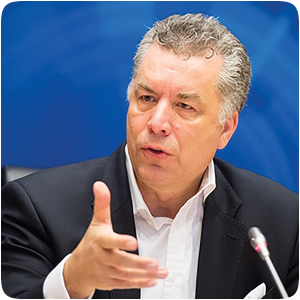Financing hydrogen energy infrastructure projects to make the European energy system more resilient and scalable
 The Russian war in Ukraine requires a reorientation of our European energy policy. This means above all the accelerated expansion of renewable energy, which will have an impact on energy prices in the medium term. A large-scale green power and hydrogen import strategy will also ultimately make Europe less dependent on a few suppliers of fossil energy. Scaling up alternative energy sources and carriers is more urgent than ever.
The Russian war in Ukraine requires a reorientation of our European energy policy. This means above all the accelerated expansion of renewable energy, which will have an impact on energy prices in the medium term. A large-scale green power and hydrogen import strategy will also ultimately make Europe less dependent on a few suppliers of fossil energy. Scaling up alternative energy sources and carriers is more urgent than ever.
The Pieper report on renewable energies contains, among other things, the proposal that in future these investments are "in the public interest" and should therefore be given preferential approval. The report also calls for a large-scale green power and H2 import initiative with specific volume targets. The report also proposes transitional lowcarbon solutions to reliably meet the CO2 target.
The biggest step with regards to facilitating the use of hydrogen on the EU level so far has been the Hydrogen and Decarbonized Gas Market Package, published by the European Commission in December 2021, which highlights the importance of hydrogen in the future energy system. This package is a crucial counterpart to the Fit For 55 package to develop this pathway from a regulatory side. It really has to facilitate the integration of renewable and low-carbon gases in the exiting gas grid and enable the development of dedicated hydrogen infrastructure and market, allowing hydrogen to become a key component of the energy sector. This gas package must be the tool to deliver this ambitious decarbonization trajectory in the gas sector.
Our task is now to accelerate. Europe's hydrogen economy is being built today. Clean hydrogen already proves its value to decarbonize our economy. And – even better – it is beginning to be competitive also from an economic point of view. But we are not there yet. If we are to meet our climate goals, and end our dependence on Russian fossil fuels, we must ramp up our ambition. The European Commission has doubled in its new plan, REPowerEU, the EU hydrogen targets for 2030 to ten million tons of renewable hydrogen produced annually in the EU by 2030. And another 10 million tons in annual imports. We must call on the Commission to increase the coordination of the planning and financing for needed electricity, energy, hydrogen, CO2 and heating/cooling infrastructure and draw attention in particular to the need for a large-scale green power and hydrogen import strategy. Furthermore, we need to call on the Commission and the Member States to bring down the time needed to issue permits substantially and create fast-track permitting procedures for infrastructure that supports industry in the energy transition. Here we must emphasize the need for the development of a hydrogen backbone in Europe and further develop the interconnections across our continent.
The European Hydrogen Backbone (EHB) plays a key role with regards to accelerate the decarbonization of the European energy system. Since its foundation in 2020, the EHB initiative has already made a break-out to the development of a European hydrogen market through its work. A European Hydrogen Backbone can only create an opportunity to accelerate decarbonization of the energy and industrial sectors whilst ensuring energy system resilience, increased energy independence and security of supply across Europe with the right political framework. We need to ensure investments in the conversion of natural gas networks, which will form an essential basis of the future hydrogen infrastructure. Otherwise, the development of a hydrogen infrastructure connected throughout Europe will not be possible in the long term, as the necessary line sections are not available and accordingly no internal market for hydrogen trading is created.
The EU recovery plan, NextGenerationEU, is worth 750 billion euros over 4 years. Over one third of this will finance the goals set in the European Green Deal to ensure sufficient renewable electricity to produce the renewable hydrogen. 9.3 billion euros of recovery funds are going straight into hydrogen projects. At the same time, the Commission is assessing State Aid for hydrogen projects as a priority. The entire hydrogen transition is about cooperation to de-risk investment, build a massive project pipeline and push the innovation frontier. The recently launched new Clean Hydrogen Partnership will add one billion euros to research and innovation, matched by another one billion from industry. It's a new step to bring innovative technologies from the laboratory to the factory floor and, ultimately, to European businesses and consumers.
Because for this cooperation to intensify and become a virtuous cycle industry and private investors need predictability. The EU is giving targets for 2030. The technology and public investment are getting on stream. The Commission has recently presented, as part of REPowerEU, the hydrogen accelerator. With this, all regulatory measures announced in the European hydrogen strategy have now been completed. This means that the actual construction of an integrated gas and hydrogen infrastructure, including storage and port infrastructure can start.